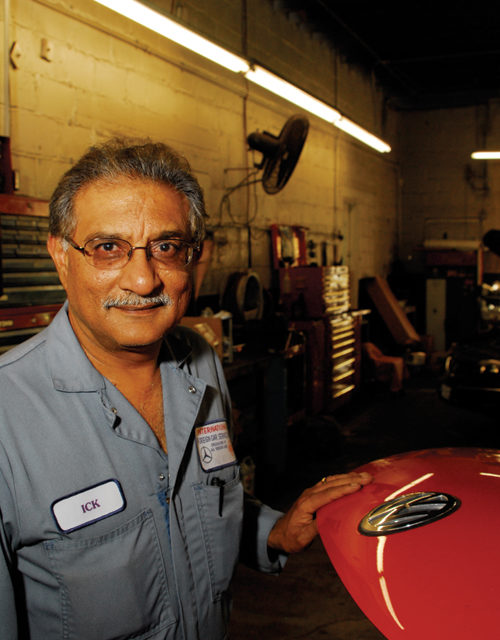
Iqubal “Ick” Moledina of International Foreign Car Service, Westminster, feels it is worthwhile to check one’s whole car in the process of accessing the cost of keeping it.
Written By Scott Braden, Photos by: Gregory Blank
Sherry Dillon is the proud owner of a 1989 Mustang LX 5-liter manual shift which, quite frankly, has seen better days. A car enthusiast, Dillon, formerly of Westminster, whose father, Dr. Deogracias Faustino, has a practice in Hampstead, finds it difficult to part with her 22-year-old “classic.”
“Everything [in my Mustang] has been breaking down and I don’t know where to start,” she said. “But with no car payments and low insurance rates, I can afford the upkeep. I am also eligible for historic tags, which allow exemption for emissions. And how cool is it to have historic tags!”
Dillon feels that she’s recycling the car rather than just trashing it. And she also looks askance at all the new muscle cars with their retro designs, which she feels are trying to get back some of the magic that she already has in her car.
“I have a lot of sentimental reasons to keep it,” said Dillon. “You become so emotionally involved with the car, because there are so many great memories attached to it: I feel I’m young again and don’t have that many responsibilities; that I’m carefree and outgoing.”
Incidentally, Dillon, who now lives in Owings Mills, also owns a 2003 Kia Sorento, which she regards as a utilitarian car. But like many car owners, she is emotionally attached to the older vehicle. So the question is, when do you know with certainty when it is time to break off the love affair with your clunker and replace it with a newer model?
According to Murphy Graham, owner of J & M Auto Services, Inc. in Sykesville, the answer is obvious: It is when you have to spend too much money on it.
“There’s not a mileage limit anymore; I’ve seen some cars reach 300,000 miles,” said Graham. “But when the repairs exceed the cost of the vehicle, that’s when you let it go. Still, people are holding on to their cars, which makes it harder for us to work on them. But people are finding that a service payment is cheaper than a car payment.”
Iqubal “Ick” Moledina, co-owner of Westminster’s International Foreign Car Service and a man with more than 30 years of experience around cars, agreed with Graham.
“It all depends on the type of car you have and what’s wrong with it,” said Moledina, “because used car values have gone up. Suppose you’re going to spend ÔX’ amount of dollars to replace that which will cost you ÔX’ or more: That’s the scale I use when I talk to people about when they should or shouldn’t spend money on repairs.
“Usually, what I try to do when it comes to that point,” he said, “is check the whole car to see what’s going to come up. The transmission, the brakes, that sort of thing. Then you add everything together and see how long the car is going to last. If you’re repairing the engine and the transmission is not shifting well, it’s time to stop and say, ÔThat’s it.’ If you’re going to spend money on fixing the brakes or exhaust, also check to see if the rest of the car is okay.”
Rick Lynn, a parts specialist at Eldersburg Auto Parts, agreed. “At some point with any vehicle the repair costs may seem prohibitively high.”
Lynn, who has more than three decades of experience in automotive parts, service, and sales, worked for Wheeler Kia as a parts specialist, service consultant, and service manager. During his time at Wheeler, the dealership became the No. 1 Kia dealer in the nation for customer satisfaction three years running. Lynn has also prepared and raced his own drag, stock, and sports racing cars.
“For me, the red flag goes up if the cost of the repairs exceeds half the value of the vehicle,” said Lynn. “You may need to research the value of your clunker so you can decide if it is reasonable to proceed with repairs or consider trading in the vehicle.
“On the Internet, Kelley Blue Book, Edmunds, or eBay are great resources to evaluate your clunker’s value. In our present economic climate, folks are holding on to cars longer. That has created a shortage of good used cars for sale, which has pushed used car values higher. If your clunker is worth $10,000, but needs $5,000 in repairs, it may well be time to trade it in and put the $5,000 toward a new ride.”
“The new cars of today are amazing technological creations,” said Lynn. Fuel mileage is king now. If you trade in a 20 mpg car for a 30 mpg car and drive 10,000 miles a year, you can save $600 a year on fuel alone. Manufacturer warranties keep getting longer, too. The styling and creature comforts of a new vehicle are very appealing. Incredible audio systems, navigation systems, and Bluetooth are now the norm. And very attractive financing is also available.”
“It depends on the car and the person, really,” said Ed Barnes of Barnes Service Center, Westminster. “Especially if you have a high-dollar car with lots of fancy gadgets on it, and your mileage is past the factory warranty. If you’re thinking about buying a new car, now is the time to do it. When you run out of warranty, the repairs will kill you.”

